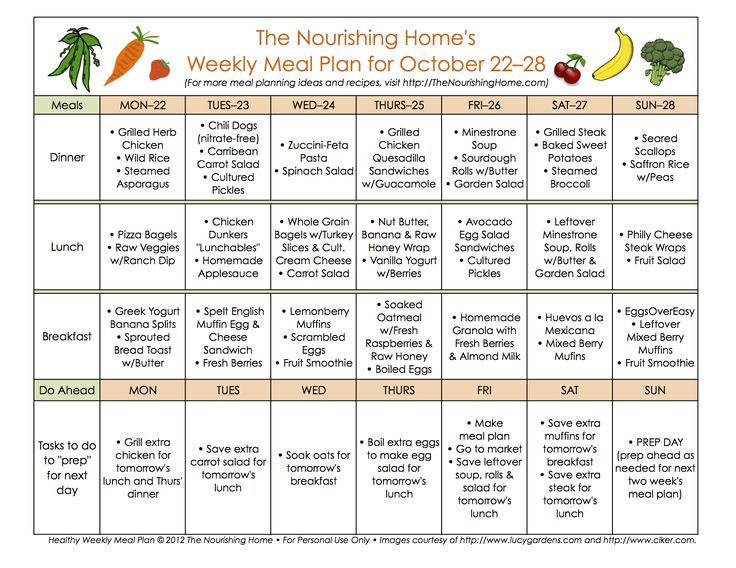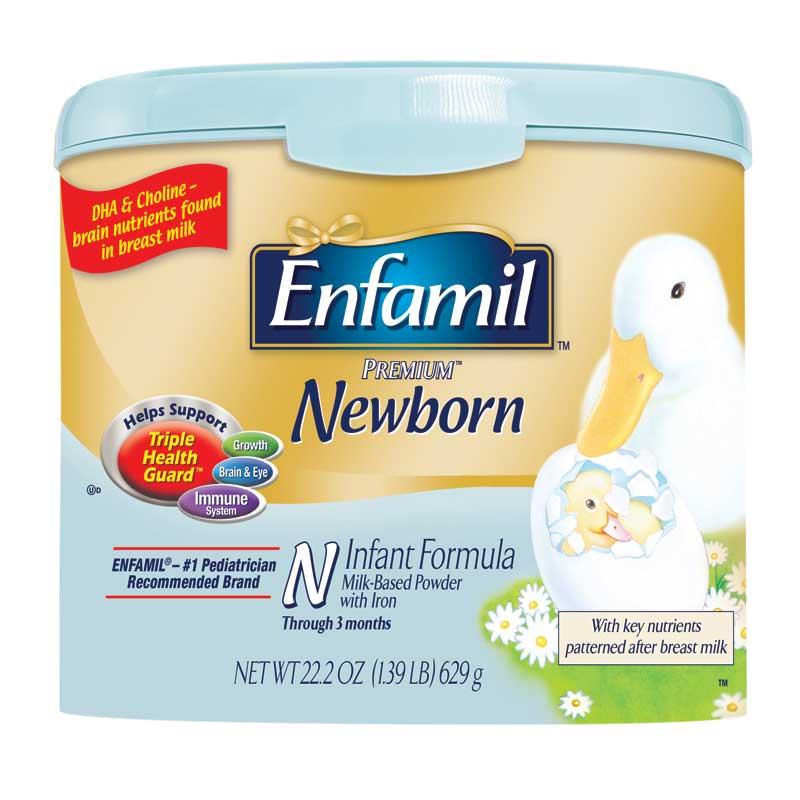Feeding oats to babies
5 Benefits of Oatmeal for Your Baby | Oatmeal as Baby's First Food
When it comes to starting your baby on solid foods, you can’t go wrong with oatmeal. It is a very nutritious food that is gentle on your baby’s digestive system and packed full of nutrients. Here are five wonderful benefits of oatmeal you should consider when you start feeding your child solid foods.
1. High in Fiber and Nutrients
Oatmeal contains high amounts of fiber, magnesium, iron and zinc. As your baby grows, they will need to eat foods that contain more nutrients and vitamins than those just found in breast milk, formula and cow’s milk alone. Oatmeal is a great way to introduce textures because the oats are soft, but still retain their structure. Oatmeal's strong nutritional profile will aid in baby's growth and development.
2. Gentle on Digestion
It is recommended for babies to start solid foods when they reach six months of age. Oats are a single grain food that are easy on your baby’s digestive system. They help promote fullness and a healthy appetite while preventing gas.
3. Prevents Constipation
Many babies tend to experience constipation when they start new foods. Oatmeal is a fiber-rich food that acts as a natural laxative to help prevent constipation. The fiber in oatmeal adds bulk to their stools to make the bowel movement process easier and gentler.
4. Blends Well With Other Foods
You are not limited in how you prepare oatmeal for your baby. You can mix fruits, vegetables and other foods into it to make it more flavorful and exciting for your baby to enjoy. You can also use it to help with the introduction of other new solids, like mashed banana or mashed berry. We love this organic baby oatmeal, easily mixed with breast milk, formula, or water for a gentle transition to solid foods. You can also choose to serve oatmeal warm or cold. With such a fast prep time and so much flexibility, oats are an ideal everyday breakfast for your little.
Voted "Best Healthy Baby Food" by Good Housekeeping - Amara's Oats n Berries flavor is 50% less sugar than the leading brand - making it a great breakfast choice for your baby or toddler.
5. Promotes Health
Oats contain high amounts of protein and other healthy ingredients that can help boost your child’s immunity and improve the condition and appearance of their hair and skin. It is also a good source of energy.
Rice Cereal versus Oatmeal:
Many parents are faced with a choice when deciding what is the best cereal to give to baby when they start the weaning process. We dive a bit into both sides of the arguments in another blog post but it comes down to what's best for your baby. Today, we find that many parents chose oatmeal for their baby because of the many benefits.
Looking for an easy, healthy breakfast for your baby? We are so here for that.
Instant oatmeal is convenient but packed with sugar and preservatives. At Amara, we don't think moms should have to choose between health and convenience--you and your baby--deserve both.
At Amara, we don't think moms should have to choose between health and convenience--you and your baby--deserve both.
That's why we created 100% organic oatmeal for babies, filled with real fruit with NO sugar or additives, ready in seconds. Simply add breast milk, formula or water, mix and it's ready to serve! But don't take our word for it. Check out our label. It's an easy read. ; )
Come explore our organic baby food designed to be mixed with breast milk, formula or water and see why Amara was voted Best Baby Food by the Bump.
Use this code for 15% off your first purchase: OATSFORBABY
Shop our best-selling Oats n' Berries HERE.
How to Make Baby Oatmeal {Different Types}
How to make oatmeal for babies, from oatmeal cereal for early eaters to steel cut oats, plus the peanut butter banana oatmeal recipe I make for my babe almost every day.

As an oatmeal lover myself I had a feeling that my little one, Olivia, was going to like it as well and turns out I was right… she’s a big fan!
That said, when I first thought about giving her oatmeal I wasn’t sure what type was best and how to prepare it. I had so many questions… What type of oats are best? Are rolled oats too thick for babies? Do you cook the oats in breast milk or add it after?
If you’re a new mama/papa, you might be wondering the same things. Luckily I’ve done all the research and I’m here to help.
For starters, oatmeal is a great food for babies. Many pediatricians suggest some sort of baby cereal (like oatmeal) as a first food because it’s mild, easy to digest and has a low risk for causing an allergic reaction.
Store-bought baby oatmeal is available, but it’s basically just oat flour (or ground up rolled oats) and it’s super easy to make yourself at home! One thing to note is that packaged baby cereals are typically fortified with iron and if you make oatmeal cereal at home the iron content won’t be as high.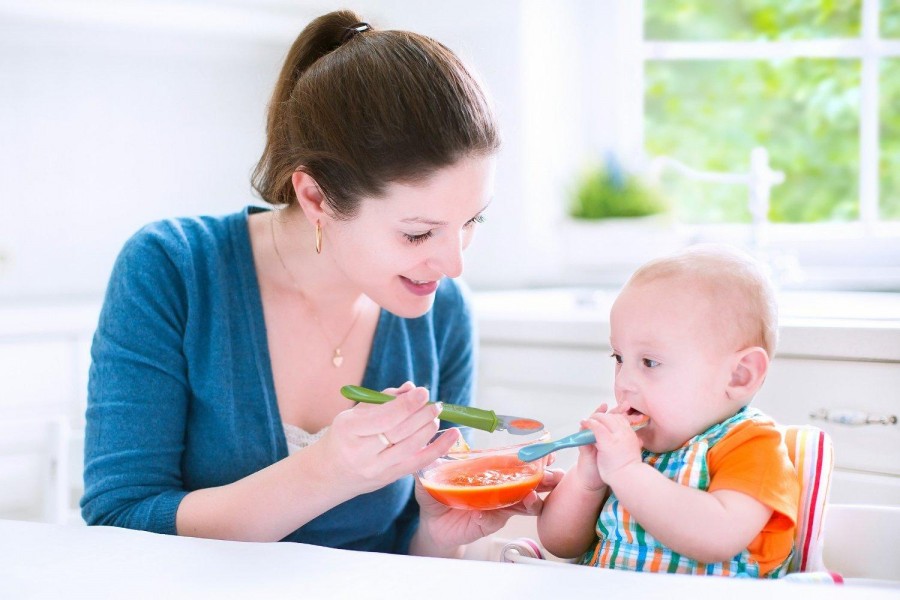
When starting solids with Olivia, we skipped the baby cereal all together and went with veggies and fruits. The first food I gave her was steamed and pureed sweet potatoes, thinned with breast milk. After introducing several pureed fruits and veggies, we started giving her oatmeal. It was probably around 7 1/2 months so we went straight to quick oats and rolled oats, cooked the way I’m sharing in the recipe below. In the beginning I thinned the oatmeal with breast milk, but now I make her oats the same way I like mine, without needing to add any additional liquid.
How to Make Oatmeal for Babies
Here I’m covering the basic method for cooking different types of oatmeal for your baby. Of course, feel free to add mix-ins and toppings to give the oats more flavor and variety when your baby is ready.
Oatmeal Cereal // 5+ months
- Grind old fashioned oats in a food processor or high-powered blender until finely ground like a flour.
- Boil 1/2 cup of water and sprinkle in 2 tablespoons of ground oats.
 Whisk continuously for 30 seconds and then stir occasionally while it cooks for the remainder of the cooking time, typically 3-5 minutes. The oats are done when they are thick and creamy.
Whisk continuously for 30 seconds and then stir occasionally while it cooks for the remainder of the cooking time, typically 3-5 minutes. The oats are done when they are thick and creamy. - Remove oats from heat and let cool. Add breast milk or formula to thin. You’ll want the cereal quite thin for new eaters.
Note: you can grind up a larger batch of oats to make the process super quick in the morning. Store the ground oats in an airtight container in a cool dark place or in your refrigerator.
Quick Oats for Babies // 6+ months
Quick (or instant oats) are the most processed of all the oat varieties. They are pre-cooked, dried, and rolled and pressed slightly thinner than rolled oats. They cook faster than steel cut or rolled oats, but they also lose a bit of texture in the cooking process so they tend to be mushy.
- Bring 1/2 cup of water to boil, add in 1/4 cup of quick oats and stir to combine. Reduce heat to medium and cook for 1 minute, stirring occasionally.

- Remove from the heat and let cool. Add breast milk, formula or water, if needed to get the oats to the desired consistency. Add mix-ins and toppings of choice.
Old Fashioned Rolled Oats for Babies // 6+ months
Old fashioned rolled oats are oat groats that have been steamed and then rolled which speeds up the cooking process for all of us at home.
- Add 1/4 cup of old fashioned oats and 3/4 cup water into a pot over medium high heat and stir to combine. Heat over medium-high heat for 5-7 minutes or until all the liquid has been absorbed.
- Remove from the heat and let cool. Add breast milk, formula or water, if needed to get the oats to the desired consistency. Add mix-ins and toppings of choice.
Steel Cut Oats for Babies // 6+ months
Steel cut oats are the least processed oats. The oat groat (the full oat “grain”) is cut into two or three parts to get to steel cut oats. That said, they’re also the most dense and chewiest oatmeal option so they’re good for older babies. I still don’t make steel cut oats for Olivia and she’s 12 months old!
I still don’t make steel cut oats for Olivia and she’s 12 months old!
- Bring 3/4 cup of water to boil, add in 1/4 cup of steel cut oats and stir to combine. Return mixture to a boil and then reduce to a simmer for 20-30 minutes or until most of the water is absorbed. Stir occasionally during cooking.
- Remove from the heat and let cool. Add breast milk, formula or water, if needed to get the oats to the desired consistency. Add mix-ins and toppings of choice.
Health Benefits of Eating Oatmeal for Babies
Oatmeal is a wonderful food for babies for a variety of reasons. It’s gentle on their tummies and packed with fiber, magnesium, iron and zinc. Little ones often experience constipation as they introduce solid foods into their diet, so oatmeal is a great intro food as it acts as a natural laxative.
How to Flavor and Season Oatmeal For Babies
When making oatmeal for babies it’s fun to switch up the flavors and toppings instead of feeding them plain, boring oats.
Olivia eats just about anything and I attribute that to offering her a variety of foods and seasoning things early on. In the beginning I seasoned her purees with aromatic spices like cinnamon and nutmeg and now she loves food with flavor. Her latest favorite is this tofu pumpkin curry.
I have given Olivia a variety of oatmeal flavors, but typically I make her oatmeal the same way I make my favorite peanut butter banana chia oatmeal. I cook it with additional water (so it’s voluminous and extra creamy), cinnamon and I also add banana slices in with oats. As it cooks, I mash the banana slices so they soften and mix throughout, adding a subtle sweetness (without adding any actual sugar). After cooking, I stir in ground flaxseed or chia seeds and peanut butter.
Adding Peanut Butter to Oatmeal
I like mixing the peanut butter in with the oatmeal for some healthy fat and protein. I also like that it gives her a good amount of exposure to peanuts, which is now said to be key for avoiding food allergies. Of course, be sure to talk to your pediatrician about introducing peanuts to your little one and make sure they tolerate it before adding it to their oatmeal. I also recommend using peanut butter that has only one ingredient (peanuts) so there’s no added oil, salt or sugar. Peanut butter is my g0-to choice, but you can use other nut butter like almond, cashew and sunflower seed butter if you want to switch it up!
Of course, be sure to talk to your pediatrician about introducing peanuts to your little one and make sure they tolerate it before adding it to their oatmeal. I also recommend using peanut butter that has only one ingredient (peanuts) so there’s no added oil, salt or sugar. Peanut butter is my g0-to choice, but you can use other nut butter like almond, cashew and sunflower seed butter if you want to switch it up!
Use Leftover Oatmeal as a Thickener
You can also use leftover cooked oatmeal for babies to make combination purees or to thicken purees that are too thin! Just toss the cooked (and cooled) oatmeal into a blender with the fruit or veggies you want to combine it with. Puree until it’s reached the desired consistency and serve.
How to Turn Oatmeal into a Finger Food for Babies
One cool thing I realized after refrigerating some of Olivia’s oatmeal is that cold oats sort of congeal and stick together. When this happens, I just break apart the oats and serve them to Olivia cold as finger food. It can get a bit messy but she LOVES it so I give it to her all the time!
It can get a bit messy but she LOVES it so I give it to her all the time!
Of course there are some additional ways to prepare oatmeal as a finger food for babies/toddlers including baked oatmeal cups, regular baked oatmeal (readers have told me their babies love this blueberry baked oatmeal recipe), oatmeal baby pancakes and even porridge fingers!
How to Store Leftover Oats
Store leftover oats in an air-tight container in the fridge for up to 4 days. If the leftover oats have breast milk or formula added to the oats, you should follow the storage guidelines for the milk in terms of how many days you can keep it. I personally like using fresh breast milk to thin the oats because it stays fresh for about 3 days, whereas previously frozen breastmilk usually needs to be used within 24 hours.
The oatmeal will thicken as it sits so you can serve it in mushy finger foods chunks like I mentioned above (if your baby is good with finger foods) or you can add water, breast milk or formula to thin it out before serving.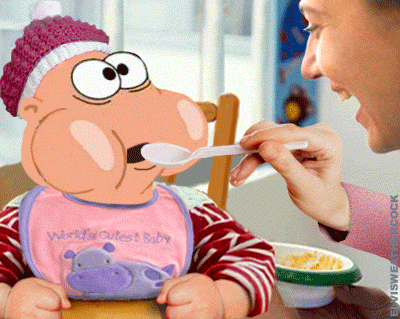 I give it to Olivia cold and she gobbles it up, but you can warm it up a bit before serving if you want.
I give it to Olivia cold and she gobbles it up, but you can warm it up a bit before serving if you want.
More Baby Recipes to Try
- 10 Baby Food Purees (Stage 1)
- 6 Baby Food Combinations
- Banana Pancakes for Babies
- Introducing Solids to Baby
- Baby (+ Toddler) French Toast
- Peach Baby Food
- Carrot Baby Food
- Banana Puree
- Healthy Smash Cake
- Baby Yogurt Melts
More Oatmeal Recipes to Try
- Apple Baked Steel Cut Oatmeal
- Baked Blueberry Oatmeal Cups
- Creamy Steel Cut Oats
- Berry Baked Oatmeal Bars
Be sure to check out my full collection of oatmeal recipes as well as all of the baby food recipes here on EBF.
Baby Oatmeal
4 from 86 votes
Here’s the recipe for oatmeal that I make for Olivia almost daily. I cook the bananas in with the oats so they soften and add a nice hint of sweetness without added sugar and then stir in ground flaxseed (or chia seeds) and peanut butter for extra nutrition and flavor!
Print Recipe Pin Recipe
Prep Time 5 minutes
Cook Time 7 minutes
Total Time 12 minutes
Servings 1
- 1/4 cup old fashioned rolled oats
- 3/4 cup water
- 1/4 banana, sliced
- pinch of cinnamon
- 1 teaspoon ground flax or chia seeds, optional
- 1-2 teaspoons peanut butter
- breastmilk, formula or water to thin, if needed
- toppings of choice: fresh berries, more peanut butter, more bananas
Add oats, banana slices and cinnamon into a pot.
 Add water and stir to combine. Heat over medium-high heat for 5-7 minutes or until all the liquid has been absorbed. Be sure to stir the oats several times while cooking to make sure the banana slices melt into the oats. You’ll know the oatmeal is done when all the water has been absorbed and the oats are creamy and fluffy.
Add water and stir to combine. Heat over medium-high heat for 5-7 minutes or until all the liquid has been absorbed. Be sure to stir the oats several times while cooking to make sure the banana slices melt into the oats. You’ll know the oatmeal is done when all the water has been absorbed and the oats are creamy and fluffy.Remove pot from heat and stir in ground flax and peanut butter, if using.
Portion oats into a bowl and let cool before serving. Oats can be warm, but you don’t want them to be too hot. If the oats are too thick (sometimes this happens as the oats cool) add a splash of breast milk, formula or water to thin. Feel free to add toppings like fresh berries, more peanut butter or banana chunks.
Serving: 1 Calories: 150kcal Carbohydrates: 22g Protein: 5g Fat: 5g Saturated Fat: 1g Sodium: 47mg Potassium: 231mg Fiber: 3g Sugar: 5g Vitamin A: 19IU Vitamin C: 3mg Calcium: 21mg Iron: 1mg
DID YOU MAKE THIS RECIPE?
Please leave a comment and star rating on this post and share on social media using the hashtag #eatingbirdfood. I love seeing your recipe shares!
I love seeing your recipe shares!When to introduce oatmeal into complementary foods for babies
— Ekaterina Borisovna, is it possible to give oatmeal for the first complementary foods and how useful is it for a child?
- Oatmeal is a gluten cereal, so it is not suitable for the first feeding . But in the second half of life - depending on when you started cereal complementary foods - the baby can try this wonderful product in all respects.
Benefits of oatmeal for children
- Rich in protein, vegetable fats, is an excellent source of slow carbohydrates, energizes the baby for a long time, creates a feeling of satiety.
- The amino acids that make up this porridge are involved in protein synthesis, building muscle fibers and the formation of protective antibodies.
- Useful fiber has a protective effect on the mucous membrane of the gastrointestinal tract, and also stimulates the bowels.

Oatmeal naturally combines a variety of vitamins B, E, PP, as well as potassium, magnesium, phosphorus, iron, copper, iodine, zinc and other micronutrients.
- B vitamins are involved in metabolic processes, including those in nerve cells.
- Calcium and phosphorus help strengthen bones and teeth.
- Iodine is essential for normal thyroid function.
- Potassium normalizes the functioning of the cardiovascular system.
— Pediatricians do not recommend ordinary oatmeal for complementary foods. What is the reason for this?
- Adult oatmeal is made from whole oatmeal that has undergone minimal mechanical processing. Such grain contains more useful substances, but absolutely is not suitable for baby food . The emerging enzyme system of the baby is not yet ready to break down the coarse structure of oatmeal. And the use of porridge from it, most likely, will cause disturbances in the work of the immature gastrointestinal tract. Therefore, oatmeal from an adult diet is not suitable for feeding children under one year old.
Therefore, oatmeal from an adult diet is not suitable for feeding children under one year old.
Oatmeal in complementary foods: what and how much to give
- What should be oatmeal for a child under one year old?
— For baby food, fragrant oatmeal is used, obtained by grinding oat kernels, which have undergone a special heat treatment. It retains the maximum amount of useful substances, and its delicate structure has a protective effect on the mucous membrane of the digestive tract.
Types of baby oatmeal
— Dairy-free mono porridge is suitable for the first feeding with oatmeal and feeding babies with allergies. Toddlers who are not allergic to cow's milk proteins can try milk oatmeal with goat's or cow's milk. Do not forget that goat's milk is closer in structure to breast milk and is easier to digest, because when it is curdled in the stomach, a tender loose clot is formed, which is well broken down by enzymes.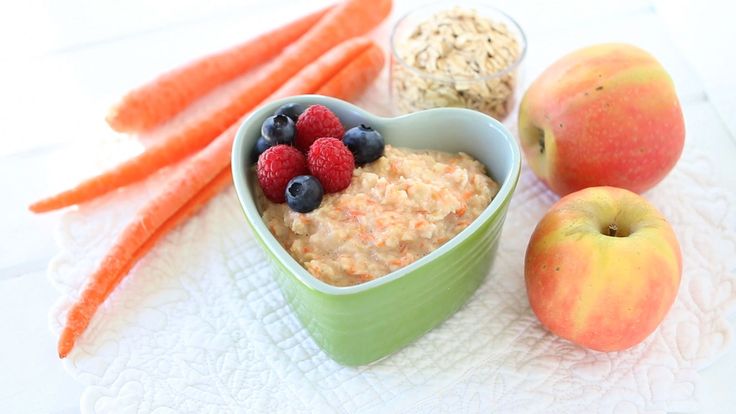 It is also less allergenic, so goat's milk cereals are suitable for feeding children at risk of developing an allergy to cow's milk protein .
It is also less allergenic, so goat's milk cereals are suitable for feeding children at risk of developing an allergy to cow's milk protein .
Fruits, vitamin-mineral complexes, probiotics can be added to porridge to improve taste, as well as to enrich it with fiber and useful micronutrients. This normalizes digestion and helps the baby better adapt to a new type of product. In addition, nutritional supplements provide a complete diet.
— When to introduce oatmeal into baby food?
- Oatmeal - complementary foods for a child over 6 months of age, it is introduced only after acquaintance with gluten-free cereals - rice, corn, buckwheat. If complementary foods are not started before six months, this does not mean that you can give oatmeal for the first complementary foods. First of all, you still need gluten-free cereals, you can’t use gluten-containing oatmeal. Let me remind you that gluten is a protein that is difficult to digest, and its introduction too early can provoke disturbances in the gastrointestinal tract.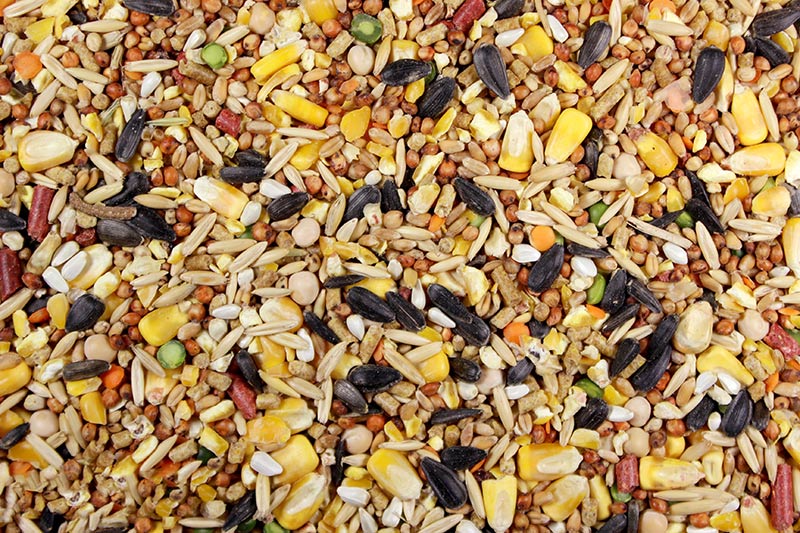
See also
- about gluten-free cereals for the first meal
— How much oatmeal should a child be given?
- Oatmeal is given in accordance with age norms. The first complementary food is a few teaspoons, gradually the amount of porridge is brought to the desired volume.
Medium serving size of oatmeal:
- 6-7 months 100-150g;
- 7-8 months - 180 g;
- 9-12 months - 200 g;
All figures are arbitrary: the baby can eat a little less, a little more, it's not critical. But we must remember that oatmeal contains a lot of phytic acid, which is able to form insoluble compounds with calcium and remove it from the body. Therefore, you can offer oatmeal to your baby no more than two or three times a week and only once a day.
Allergy to porridge
— Ekaterina Borisovna, why do some children refuse oatmeal?
- Toddlers usually enjoy eating oatmeal. But there are exceptions to all rules. If there is a refusal of oatmeal, first of all it is worth evaluating the reaction of the child to this type of complementary foods. Perhaps he is worried about digestive problems after eating it, which means that the body is not yet ready to break down gluten.
But there are exceptions to all rules. If there is a refusal of oatmeal, first of all it is worth evaluating the reaction of the child to this type of complementary foods. Perhaps he is worried about digestive problems after eating it, which means that the body is not yet ready to break down gluten.
If everything is in order with the tummy, the child may simply not like the taste of porridge . What you can try to do, provided that oatmeal is well tolerated:
- change porridge from dairy-free to dairy;
- replace cow's milk porridge with more tender and tasty goat's milk porridge;
- offer porridge with fruit and berry additives.
From such a variety, the baby will surely be able to choose a dish that will suit his taste. If this does not help, never force-feed a child . You should postpone the introduction of oatmeal for a couple of weeks or a month. After a while, the baby will be able to re-evaluate the taste of this wonderful food.
— Food allergies are not uncommon. Can a child be allergic to oatmeal?
- Allergy to oats is extremely rare. Skin rashes and stool disorders with the introduction of oatmeal are most likely associated with gluten intolerance. In this case, the following are possible:
- a transient state - it is caused by age-related immaturity of the enzyme system;
- true allergy is a congenital condition called celiac disease.
If signs of allergy appear, you should pause for two to three weeks and again offer oatmeal complementary foods to the baby. If the symptoms return and occur when eating other foods containing gluten (wheat, barley porridge), it is important to contact a pediatrician to clarify the diagnosis.
But not always when eating oatmeal, the child reacts to gluten. The cause of the allergy may be the milk in its composition. This happens in pediatric practice. Let's say the baby has never tried porridge or mixtures based on cow's milk before, and the mother followed a dairy-free diet. In this case, he already has a certain probability of developing an allergy to milk protein. And as soon as the baby's diet is supplemented with a highly allergenic cow's milk protein, he begins to react with skin rashes and stool changes.
In this case, he already has a certain probability of developing an allergy to milk protein. And as soon as the baby's diet is supplemented with a highly allergenic cow's milk protein, he begins to react with skin rashes and stool changes.
Buy oatmeal for feeding or cook yourself
- It has already been noted that regular oatmeal is undesirable for an infant . But some parents turn a blind eye to this. Continuing the conversation, we will once again touch on home-made cereals and cereals of industrial production. What's better?
— For children of the first year of life, it is preferable to use ready-made baby cereals of industrial production. There are several reasons for this.
— How to cook oatmeal for complementary foods: what should parents remember?
— For making porridge at home, high quality flakes are used, previously ground in a blender to the state of flour. Consumption - 5 g (approximately 1 tsp) per 100 ml of water. Oatmeal is poured into boiling water and boiled, stirring constantly, for 7-10 minutes.
To improve the palatability of porridge , you can add a little breast milk or the usual milk formula, butter. Fruit or fruit and berry puree, fresh fruits and berries can be tasted after a year. Honey, due to its highly allergenic properties, should not be given to babies.
— Consider instant cereal for kids. Which oatmeal should you choose?
- First of all, you should pay attention to the manufacturer. Choose large manufacturers that have proven themselves in the baby food market.
Next, we study the packaging. It should look neat, be free of dents and damage. High-quality applied paint will not wear off at the slightest friction.
Information about the composition of porridge must be clearly written in an understandable language. In addition to oatmeal, in the list of components you can find cow or goat milk, fruit and vegetable or fruit and berry supplements, vitamins with minerals, probiotic flora.
Baby food porridge may not contain:
- salt;
- modified starch;
- artificial colors;
- genetically modified foods;
- fragrances;
- flavor enhancers.
— How does MAMAKO ® baby cereal help digestion?
— The manufacturer's line includes children's oatmeal with goat's milk in two varieties — milk oatmeal and milky oatmeal with prunes, which perfectly diversify the diet with new taste sensations.
Both cereals contain 32% healthy goat's milk, which is perfectly digestible and has a positive effect on digestion. In the stomach, it curdles into a soft clot, and its small fat globules and fatty acids are easily broken down in the baby's body.
Also, these cereals are enriched with the best helpers of the child's body:
- Ca+Fe+I - an indispensable complex for the prevention of rickets, iron and iodine deficiency;
- fat-soluble vitamins A, D, E, K - are involved in cell metabolism, enzyme systems, redox processes;
- vitamins of group B - responsible for the formation of the nervous system, take part in energy metabolism, muscle work;
- vitamin C - the main antioxidant;
- niacin, folic and pantothenic acids, biotin and other useful substances.
Of all the variety of baby food, I recommend my patients to opt for cereals with goat's milk from MAMAKO ® . These oatmeal porridges have a delicate taste, an optimally balanced composition, are well tolerated and cause allergic reactions to a lesser extent in babies predisposed to them.
Oatmeal is an indispensable product in the nutrition of a young child. It is an excellent source of fiber and complex carbohydrates and contains the most important nutrients for your baby. Oatmeal not only normalizes bowel function, but also has a mild enveloping effect on the stomach and facilitates digestion.
Oatmeal not only normalizes bowel function, but also has a mild enveloping effect on the stomach and facilitates digestion.
For the first feeding, it is better to use ready-made cereals. Healthy babies can buy cereals both in cow's and goat's milk. To feed babies prone to functional disorders of the digestive tract, as well as those at risk of developing allergic conditions, it is preferable to use oatmeal with goat's milk. They cause digestive disorders to a lesser extent and are less allergenic.
* Breast milk is the best food for babies. WHO recommends exclusive breastfeeding for the first 6 months of a child's life and continued breastfeeding after complementary foods are introduced until the age of 2 years. Before introducing new products into the baby's diet, you should consult with a specialist. The material is for informational purposes and cannot replace the advice of a healthcare professional. For nutrition of children from 6+ months. The product is certified.
at what age to give, how much. How to cook oatmeal for children, recipe
Contents
Hercules and other types of oatmeal are considered much healthier than other cereals. After all, this culture contains a lot of trace elements, vitamins and is well digested. Therefore, most parents try to introduce porridge from oats into complementary foods as early as possible. But pediatricians advise to act more carefully. After all, this porridge, like other products, has its own contraindications, and its abuse can lead to a violation of the baby's health.
Benefits of oatmeal for children
Its grains contain a record content of folic acid, thiamine, riboflavin and other B vitamins. Oatmeal helps to restore hemoglobin levels, strengthen the bones of the skeleton, connective tissue, visual apparatus, nervous system. It supports the work of endocrine organs, helps to eliminate toxins from the body, improves blood composition.
Regular use of oatmeal provides the cells with essential nutrients, improves the condition of the skin and mucous membranes, eliminates their irritation. The delicate structure of the product avoids inflammatory reactions from the digestive tract. And the fiber of cereals helps the intestines and perfectly relieves it of constipation. In addition, oats are high in calories. Due to the high content of protein and fats, it quickly restores physical strength, provides satiety for a long time.
The delicate structure of the product avoids inflammatory reactions from the digestive tract. And the fiber of cereals helps the intestines and perfectly relieves it of constipation. In addition, oats are high in calories. Due to the high content of protein and fats, it quickly restores physical strength, provides satiety for a long time.
Despite the saturation of carbohydrates, the glycemic index of oatmeal is low, it is allowed to be eaten by children with impaired glucose metabolism. Oats can harm the body with gluten intolerance. Its grains contain a lot. Do not use this porridge with persistent diarrhea.
Oatmeal for children with diabetes is contraindicated due to the presence of starch in it.
Oatmeal for children: at what age to introduce complementary foods
Babies up to 7-8 months often cause allergies to gluten, as insufficiently necessary enzymes are produced in their intestines. Therefore, it is recommended to give your child oatmeal no earlier than at 9-10 months. Until this period (up to 6 months), the menu should be expanded with gluten-free cereals: rice or buckwheat.
Until this period (up to 6 months), the menu should be expanded with gluten-free cereals: rice or buckwheat.
How to cook oatmeal for a child
Choose from the whole variety of oatmeal groats sold, it is desirable to use ordinary long-cooked oatmeal. It is more troublesome with it, but this product contains the whole set of useful substances, and there are not many of them in refined ready-made food. Whole grains of oats for babies are not advisable to use. They cook for a very long time, losing a lot of vitamins in the water.
General recommendations
For children under 1 year of age, grind the cereal in a coffee grinder, and cook the porridge in water without sugar or salt. It is allowed to use oatmeal - oatmeal. You can add a little butter or kefir to the finished dish. For those who have teeth, you can cook crushed or whole flakes to train your chewing skill.
First serving - no more than 2 tsp. At the beginning of complementary foods, oatmeal does not need to be combined with other new foods. It is better to give it in the morning in order to take action in time for allergies. If the child does not have stool disorder, colic, skin rash and itching during the day, oatmeal is allowed for the child. More than 2 times a week to feed the baby with this product should not be in order to avoid a lack of calcium. Phytic acid in the composition of cereals prevents its absorption
It is better to give it in the morning in order to take action in time for allergies. If the child does not have stool disorder, colic, skin rash and itching during the day, oatmeal is allowed for the child. More than 2 times a week to feed the baby with this product should not be in order to avoid a lack of calcium. Phytic acid in the composition of cereals prevents its absorption
Milk-based oatmeal is allowed for children over 1 year of age. It can be cooked in milk or a mixture of it with water, fruit purees can be added to the dish: banana or pear. You can sweeten oatmeal with a little sugar, honey, or berries.
How much oatmeal should I give my child?
- At 1-2 years old, the size of one medium serving of porridge is about 100 g.
- Children 2.5-3 years - about 150 g.
- At 4–5 years, a single dose can be increased to 200–250 g.
Oatmeal with milk for a child, recipe
Ingredients for 1 serving:
- 3 tablespoons of oatmeal;
- 100 ml milk;
- 100 ml filtered water;
- 0.







